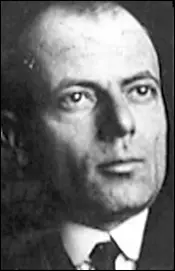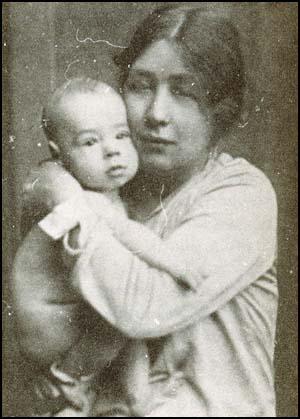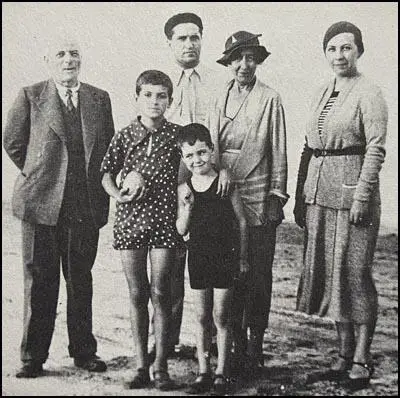Silvio Corio

Silvio Corio, the son of Luigi Corio and Chiara Domenica Corio, was born in Turin on 28th October 1875. His father died while he was a teenager and he was sent to a technical high school to learn the trade of printing. (1)
As a youngster he joined the Turin Socialist Club. In his early twenties he become involved with the anarchist movement.Corio became active as a socialist propagandist among other printers. Like many left-wing socialists of his generation, he became a supporter of Prince Peter Kropotkin rather than Karl Marx. (2)
Corio was opposed to serving in the Italian Army and served most of his military service (July 1897 - December 1898) in a disciplinary prison battalion. On his release became an important figure in the emerging Italian trade union movement. Eventually he fleed to France where he lived as a stateless refugee. (3)
Cario worked as a journalist under Felice Vezzani who published the newspaper, Vita Nuova (New Life) aimed at Italian exiles in France. He also wrote articles for the anarchist newspaper, Le Libertaire. He became friends with Emma Goldman, the American anarchist who was living in Paris at this time. In 1900, the French authorities issued him with an expulsion order. He went into hiding but was arrested and after being briefly imprisoned he decided to move to London. (4)
Silvio Corio - Anarchism
Corio lived with fellow socialist, Clelia Alignani, and in 1902 she gave birth to a son. In October 1904 he returned to France where he became a printer. He spent his free time in agitation, in distributing propagandist letters and circulars, and in other anarchist activities. Corio and Alighani and her two children moved back to Italy for a while but eventually returned to London. (5)
Cario attended the International Anarchist Congress in Amsterdam in 1907 as a delegate and there met British anarchist Guy Aldred. Cario wrote several articles for anarchist journals, including an attack on Henry Hyndman, leader of the Social Democratic Federation, who supported the building up of the British Navy. In 1911 he participated in the famed International Syndicalist Congress held in London. (6)
Worker's Dreadnought
During the First World War the 40 year-old Cario met Sylvia Pankhurst who had recently formed a branch of the Women's International League for Peace and Freedom in the East End. In a continuing attempt to maintain a balance between women's suffrage and peace agitation the East London Federation of Suffragettes. changed its name in March 1916 to the Workers Suffrage Federation (WSF), symbolically acknowledging its long-held goal of universal suffrage. (7)
Silvio Corio began contributing articles to Pankhurst's Workers' Dreadnought. This included a long historical piece on Karl Marx in Fleet Street. (8) The couple became lovers and he joined the staff of the newspaper and by 1919 was a member of the management team. Later that year they attended a conference of the Italian Socialist Party in Bologna. At the conference they met Antonio Gramsci, one of the leading members of the party. (9)
On 31st July, 1920, a group of revolutionary socialists attended a meeting at the Cannon Street Hotel in London. The men and women were members of various political groups including the British Socialist Party (BSP), the Socialist Labour Party (SLP), Prohibition and Reform Party (PRP) and the Workers' Socialist Federation (WSF). It was agreed to form the Communist Party of Great Britain (CPGB). Arthur McManus was elected as the party's first chairman and Tom Bell and Harry Pollitt became the party's first full-time workers. (10)
Sylvia Pankhurst joined Communist Party against the wishes of Silvio Cario, who had been appalled by the way Lenin had persecuted anarchists in the Soviet Union. Sylvia also had doubts about Lenin's government and in March, 1921, the Workers' Dreadnought published an article by Herman Gorter, entitled "Open Letter to Comrade Lenin." Gorter rejected Lenin's arguments that he had made in his pamphlet, Left-Wing Communism: an Infantile Disorder (1920) and praised the work of Silvio and Sylvia "to raise the masses as a whole, and the individuals to a higher level, to educate them one by one to be revolutionary fighters, by making them realise (not through theory only, but especially by practice), that all depends on them, that they are to expect nothing from foreign help, very little from leaders, and all from themselves." (11)
Sylvia Pankhurst
Silvio and began living with Sylvia Pankhurst, and after the Workers' Dreadnought came to an end in 1924 they opened a café together. (12) They then moved to Woodford Green where Sylvia concentrated on her writing. Silvio and Sylvia also opened Red Cottage bookshop. They sold books and pamphlets written by Jack London, Charles Bradlaugh, Edward Carpenter, Olive Schreiner, William Cobbett, Mary Wollstonecraft, Clara Gilbert Cole, Henry George, Keir Hardie, Maxim Gorky, Peter Kropotkin, William Morris, Karl Marx, Friedrich Engels, Antonio Gramsci and Alexandra Kollontai. (13)
In 1927, at the age of forty-five, Sylvia Pankhurst gave birth to her only child, Richard Keir Pethick Pankhurst. Sylvia Corio, who was 52, "was a proud, loving and experienced father". The boy was named after the three most important men in her life: Richard Pankhurst, Keir Hardie and Frederick Pethick-Lawrence. (14)
Sylvia did not believe in marriage and had argued in favour of free love and sexual freedom, though she never practised it indiscriminately. Two of her heroines, Mary Wollstonecraft and Clara Zetkin, had both been unmarried mothers. In an article published in The Sunday Chronicle Sylvia argued that "like most idealistic young people", she had "the notion that true love can only come once in a lifetime, and invariably, endures forever". She had changed her mind about this and "I early became convinced that no man or woman should be chained for life." (15)

Sylvia upset Emmeline Pankhurst and Christabel Pankhurst, by refusing to marry the boy's father. Several times she attempted to visit her mother, but when she arrived at the house, Emmeline refused to see her. According to Emmeline's foster-child Mary Gordon, her mother locked herself in her bedroom "like a sulky girl and refused to see Auntie Sylvia when that scarlet woman dared to call." (16)
Sylvia Pankhurst responded to this rejection by giving an interview to the News of the World in April 1928. It reported "Sylvia Pankhurst's amazing confession" that she gave birth "to a child out of wedlock - a Eugenic baby, she prefers to call it." She added: "I wanted a baby, as every complete human being desires parenthood, to love him and cherish him, to see him grow and develop and to leave behind me a being who will, I hope, carry on the best that is in me and my stock." Sylvia said she was very much in love with her son's father whose identity she refused to reveal. That he was fifty-three and foreign was all she would say. She added: "He is of a retiring disposition and hates publicity, I will not bring him publicity by naming him." (17)
Newspapers around the world, especially, the tabloids, took up the story. Christabel Pankhurst interpreted Sylvia's actions as a personal attack. She complained to friends that the newspaper headlines referring to "Miss Pankhurst" caused her no end of embarrassment as she feared being mistaken for the subject of the scandal. She told Grace Roe: "That was the biggest blow I ever received and the repercussions have not really ceased. The whole publicity was skilfully engineered to harm me." (18)
A friend, Helen Fraser, said Emmeline was "horrified and greatly distressed when Sylvia had her son." On 14th June 1928, Emmeline Pankhurst, aged 69, died. Several members of the family and former Women Social & Political Union members believe that Sylvia's public announcement sent the already weakened Mrs Pankhurst to her death. (19)

Silvio Corio, Judge Petrescu, Sylvia Pankhurst and Mrs Petrescu in Romania (1934)
In November 1935, Sylvia Pankhurst, wrote an article in The Daily Mirror about her opinions on unmarried mothers. "As a Suffragette in prison I met young expectant mothers serving sentences for having attempted suicide in fear of a censorious world. During the war, when I worked in the East End among war sufferers of every sort, girls came to me with their 'war babies'. Many had been dismissed by irate employers, some had been driven from home by angry parents. In all those years of public activity, busy as I was with other matters I had formed my own conclusions on matrimony, parenthood and the rights of children. I resolved very emphatically that I would always stand against classing any children as illegitimate, and insist that all must be entitled to equal respect and equal opportunities both as regards their parents and the community." (20)
Silvio Corio died on 11 January 1954, aged seventy-eight. Sylvia Pankhurst arranged for his cremation to take place in Manor Park, Walthamstow, but was too distressed to attend the funeral. Richard Pankhurst recalled that his mother wept unceasingly for days when his father died. Sylvia wrote to her old friend, Frederick Pethick-Lawrence: "When Richard's father died, Richard asked me not to go to the crematorium with him because he knows I am like that and he told me he would be upset if I came and begged me not to go. I can't control my tears and all that. You know I am not very well now - sometimes I feel almost the same as before but anything upsets me. I never go out now unless someone will drive me in a car and very seldom at all." (21)
Primary Sources
(1) Patricia W. Romero, E. Sylvia Pankhurst: Portrait of a Radical (1987)
Silvio Corio was born in Luigi and Chiara Domenica Corio in Turin in October 1875. He had been a rebel since youth. His father died while he was a teenager, which perhaps explains why he was sent to a technical high school to become a printer instead of being given a more formal academic training. He left before completing the course, took a job, and soon became active as a socialist propagandist among the other printers. He progressed quickly from socialism to anarchism, continuing as a propagandist, lecturing and writing on anarchism.

